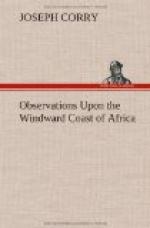When the papers came to hand which contained the substance of these remarks upon this extraordinary insect, I did not intend to annex them to the Observations on the Windward Coast of Africa, nor am I without some doubt as to the propriety of so doing; the observation of the learned naturalist only can ascertain the economy of the termite, or bug a bug, and I have therefore to apologize for obtruding these imperfect and general remarks.
SECTION III.
Of the Cameleon.
The cameleon is a native of the torrid zone, and is a genus of the lizard: the faculty of assuming the colour of every object it approaches is ascribed to it, and other singular properties; but there are many rare phoenomena not so well understood, such as its absorption and expulsion of air at pleasure, its property of living a considerable time without any kind of nourishment, and its extraordinary visual advantages, which are perhaps not to be found in any other of the wonderful works of the creation.
I have made various experiments to ascertain these extraordinary properties in this little animal; and I brought home one in a preserved state.
The first object which struck my attention, was the variation of colour; and I am persuaded that it does not assume these from the surrounding objects, but that they proceed from internal sensations of pain, or otherwise.
From the moment that the liberty of my captive was infringed upon, or when interrupted in its pursuits, it became less sensible of external objects, the vivacity of its colour, and the plumpness of its form underwent a visible change. Its natural colour is a beautiful green; and when in a state of liberty it is to be found in the grass, or lodged on the branches of some tree, ornamented with the gayest foilage; and it would appear that its liberty, and the privilege of living in the grass, are indispensible towards the preservation of its qualities. The colour of its skin, in a perfect state of health, is scarcely discernible from the trees and grass, in which it delights to conceal itself, and is not to be discovered at all without a very minute scrutiny. It remains immoveable for a length of time, and its motions are all cautious and slow, continuing to loll out its tongue, which is long and glutinous, in order to secure the little insects that are necessary to its nourishment; and I doubt not but it has an attractive influence over its prey, for I have observed them continually floating around the cameleon, when scarcely discernible in any other space. When the tongue is covered with a sufficient quantity it draws it in instantaneously, and by incessantly repeating the operation, all the insects within its reach are taken in the snare.
That its health and existence depend upon being in the grass, I am persuaded, from the change occasioned by placing it in gravel or sand, when it immediately assumes a yellow tinge, its form is reduced considerably, and the air expelled, with which the body of this animal is inflated, so as visibly to reduce the size. If they are irritated in this situation, they expell the air so strong as even to be heard, gradually decreasing in size, and becoming more dull in colour, until at length they are almost black; but upon being carried into the grass, or placed on the branches of a tree, they quickly assume their wonted solidity and appearance.




